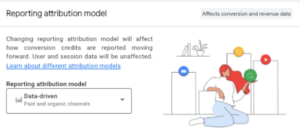Since the replacement of Universal Analytics with Google Analytics 4, advertisers have seen significant changes to a variety of Analytics features, from the way metrics are counted to the way reports are formatted. Among these changes is the newest generation of a powerful type of attribution modeling: Data-Driven Attribution. Is this all news to you? Not to worry. Today, we’re providing you with a brief overview of how attribution models work, data-driven attribution, and how you can select your preferred attribution model in Google Analytics 4 (GA4).
(By the way, if you haven’t heard about the switch from Universal Analytics to GA4, check out this blog post for a little more context.)
According to Google, “Attribution is the act of assigning credit for conversions to different ads, clicks, and factors along a user's path to completing a conversion.” An attribution model is the set of rules or the algorithms that determine how that credit is assigned. But wait, you might say, shouldn’t the credit for the conversion simply go to the last ad that the customer clicked? True, that’s one way to do it, but sometimes it isn’t so simple.
For example, it’s unlikely that every customer you’ve converted did one search, saw your ad for the first time, and immediately purchased your product or service. In a perfect world, maybe, but realistically, it’s more complicated than that.
Most customers will do several searches, and possibly view and interact with your ads multiple times before making a decision. While we could simply attribute the eventual conversion to the last ad they interacted with, it seems likely that the other ads they clicked on probably impacted their decision to convert as well. That’s something we want to account for, because it could impact our advertising strategy.
So, how do we determine how much credit to attribute to each ad that a customer interacted with before converting? One option is data-driven attribution.
Data-driven attribution distributes credit for the conversion across ads/interactions. Unlike other models, it uses account data to calculate the contribution of each interaction, so each data-driven attribution model is specific to the individual advertiser and each conversion event.
It works by using machine learning algorithms to evaluate conversion paths in the account. The model considers device type, time, number of interactions, and more to learn how different “touchpoints'' impact conversions. Data-driven attribution analyzes what has happened and what could have happened to determine which activities are driving conversions, and to what extent.
Sound interesting? You can adjust your Attribution settings in your GA4 dashboard. Click Admin on the left; then, under Property, click Attribution Settings.

Under Reporting attribution model, you can select the data-driven attribution as your preferred attribution model. Easy!
--
Relevance Advisors is here to help your ecommerce business thrive. Interested in learning more about data-driven attribution? Contact us today, or sign up for our newsletter to receive marketing tips and tricks, as well as information on digital marketing trends.